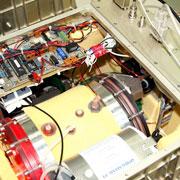 This tank can hold dozens of fish in just 3 litres of water for their trip to space.
This tank can hold dozens of fish in just 3 litres of water for their trip to space.Twenty-six baby fish are now orbiting Earth aboard an unmanned Russian spacecraft, in a long-delayed experiment that researchers hope will lead to a better understanding of inner-ear balance mechanisms in humans.
The cichlid fish (Oreochromis mossambicus) blasted off Friday morning (11:00 GMT) from Baikonur Cosmodrome in Kazakhstan, in a Foton-M3 craft atop a Soyuz-U rocket, as part of a package of life and physical science experiments organized by the European Space Agency.
Reinhard Hilbig and Ralf Anken, neuro- and developmental biologists at the University of Hohenheim in Germany, will monitor the larval fish to watch the growth of their otoliths — sensory organs that have a role in hearing and balance — in microgravity conditions during the 12-day mission.
Otoliths, also found in the inner ear of humans, are sensitive to gravity and linear acceleration and are essential for maintaining proper balance. They are composed of a mix of gelatinous material and calcium carbonate, which shift around in a viscous fluid when the head moves, stimulating hair cells and conveying information about movement to the brain.
Scientists think a misfunctioning otolith is the culprit for conditions such as Ménière's disease, which causes vertigo and 'ringing in the ears' in sufferers. But they do not yet understand exactly how this organ works. The otoliths of fish provide a good candidate for study, says Hilbig, because they function in exactly the same way as human ones but are considerably larger. This is because fish must orient themselves underwater, where other motion clues are suppressed.
Gravity groove
Previous tests have shown that larval fish exposed to 'hypergravity' conditions in a centrifuge grow smaller-than-normal otoliths than controls. This implies that otolith development is, at least in part, under neural control, says Anken. Somehow the fish brain signals the otolith to grow smaller, as it does not need to be as big or as sensitive in hypergravity as it would in normal conditions.
The next step to confirm neural control is to test whether microgravity makes developing otoliths grow to be larger (and so more sensitive) than normal. Anken says they are expecting the otoliths to "grow uncontrollably and asymmetrically" in low gravity if under neural control.
This would make the otolith an unusual bit of anatomy. "I am convinced that the mineralization of otoliths is the only known natural process of biomineralization that requires neuronal input," says Anken.
It could also point the way to treatments: controlling the neuronal process that determines otolith size in humans could be used to help those with balance disorders. Such treatments are a long way off, says Anken. "We are still doing the basic research. We first have to know how the otolith works, then we may eventually develop a treatment."
Frogs in space
Scientific curiosity about the effect of gravity on the otolith is not new. In 1970, NASA sent two bullfrogs into space to look at the effect of weightlessness on their otoliths, specifically to study motion sickness. The new experiment differs in that it looks at the brain's involvement in otolith development.
ADVERTISEMENT
It is a course that Anken has been pursuing for years. "In 1998, NASA released an announcement for a space shuttle mission and we jumped on this train," he says. It turned out to be a slow ride. Their microgravity fish experiment was launched in early 2003 aboard the Columbia space shuttle, a mission that ended in tragedy on 1 February that year when the shuttle disintegrated on re-entry over Texas. The fish experiment was lost along with the seven crew members.
They now have a second chance. Their fish are housed in a special tank, holding 3 litres of water and tipping the scales at only 18 kilograms. Scientists can observe fish behaviour through a camera system that sends video streaming back to Earth. When the experiment crash-lands back on Earth, the fish will be retrieved for more detailed study.
Visit our inspacehelpstudies_of.html">newsblog to read and post comments about this story.
